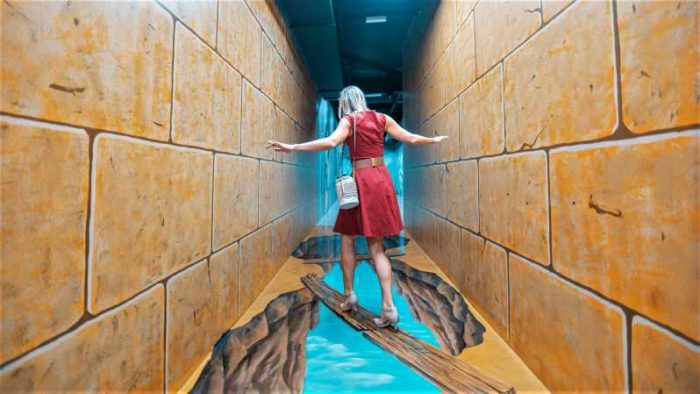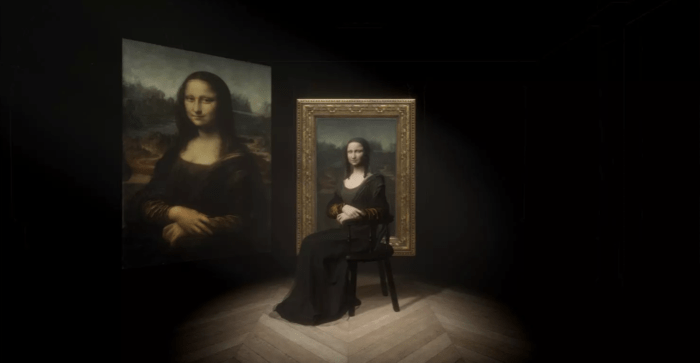Nowadays, with the development of science and technology, many museums have begun to try new technology guides, which are refreshing for tourists. Museums are no longer synonymous with history and tradition.
So, how can those high-tech and digital technologies help connect the museums and the audiences?
3D, VR (Virtual Reality) and AR (Augmented Reality) technology.
Speaking of which, we have to mention our old friend – The Louvre Museum again. In recent years, with the popularization of network 3D technology, more and more museums have established 3D virtual exhibition halls. The Louvre in France was the first museum to move its collections from its galleries to the Internet. As early as 2004, the Louvre put 35k publicly displayed collections and 130k paintings on its revamped website, and offered 3D virtual tours in four versions: French, English, Spanish and Japanese. Users only need to enter the official website of the Louvre Museum, and they can complete a 3D virtual tour at home. The immediate effect of the establishment of the virtual pavilion is the continued increase in the number of visitors to the Louvre’s website. In the year of its launch, the number of online viewers was equal to the number of tourists who actually entered the Louvre, reaching 6 million. In 2012, the Louvre’s website was viewed more than 11 million times, 1 million more visitors than it actually received in the whole year. Recently, because of the global epidemic, the number of visitors to the website is always more than that to the museum.
For the protection of cultural relics, most of the collections in museums can only be seen but not touched, but interactive 3D technology may make up for this regret. The Petrie Museum of Egyptian Archaeology in London, UK, is at the forefront of creating 3D images of its collections and developing interactive 3D technology. The Petrie Museum of Egyptian Archaeology has a collection of about 80k objects and is one of the largest museums in the world with Egyptian and Sudanese artifacts. In order to attract tourists and enhance their experience, the museum cooperated with University College London to produce high-quality 3D images of the collections with the help of 3D laser scanning technology. The museum also combines the three-dimensional visual effects brought by 3D images with motion recognition technology, trying to allow visitors to achieve a dual experience of « not only seeing, but also touching ». Moreover, it launched an iPad app called Journey to the Nile. Visitors only need to use the camera on the iPad to scan a special map of the Nile site in the museum, and the cultural relics unearthed from each site can appear on the screen one by one in the form of 3D images. By touching the 3D image, tourists can experience the effects of flipping and zooming in, and watch the cultural relics in all directions. Once the app was launched, it was immediately popular with tourists, especially young people.

As for the VR technology, the use of it has truly achieved the transfer of cultural relics or palace buildings from other places to people’s homes, allowing users to view the collections at close range without leaving home.
Using the 3D virtual function, the museum buildings and collections are reproduced in real life to create a complete virtual museum. The cultural relics in the virtual museum scene are all high-fidelity digital cultural relics corresponding to the real cultural relics in the physical museum. This virtual museum can be « moved » out for touring exhibitions, which can maximize the knowledge dissemination role of the museum. And because the exhibits and scenes all exist in the server, they can be displayed without time and place restrictions, and there is no danger of being destroyed or stolen.
With the continuous development of VR technology, more and more museums have begun to play with VR, and various « digital museums » have been established, allowing tourists to « contact » and observe the original appearance of cultural relics at a closer distance through electronic devices. This collision of high-tech and culture has ushered in an upgrade experience for the museum.
As long as you put on the VR helmet, you can « walk » in any corner of the museum. Not only that, you can also walk up and « pick up » the items in front of you, observe and study carefully, without worrying about damaging the cultural relics. For example, if we walk up and pick up this piece of china, carefully « stroke » back and forth, up and down, no one will stop you. This is the charm of the VR museum.
The application of virtual reality technology in museums has played an important role in the protection of cultural relics, the restoration of history, and the better play of educational and social functions. Through the VR museum, these historical records can be preserved forever, allowing us and more people in the future to learn about the past that has been far away from us. In order to let more young people walk into the door of the museum and understand the history and culture of our existence in the world, the traditionally rigid museums have also begun to keep up with the pace of modern technology.
Not only VR, but AR is also a very popular way of viewing exhibitions. Let’s walk into a museum first, find a favorite exhibit, take out our mobile phone and point it at the exhibit that is silent in the glass box, we will see it appear on your mobile phone, and it will also show the past and present of this exhibit. , artistic features and cultural value.

“Showing off” is just a means, humanities and communications are the goal.
It is true that science and technology make national treasures « speaking », but the specific content must be based on the museum’s excavation and arrangement of the historical stories and cultural connotations of the cultural relics. Showing off skills is only a means, and the integration of « humanities + technology » is the ultimate goal, to attract more clients, to make it easy for them to feel and get closer to the history and culture, to make more people, especially young people interested in this field.


